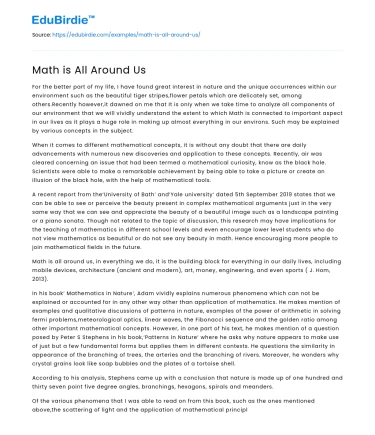For the better part of my life, I have found great interest in nature and the unique occurrences within our environment such as the beautiful tiger stripes,flower petals which are delicately set, among others.Recently however,it dawned on me that It is onIy when we take time to analyze all components of our environment that we will vividly understand the extent to which Math is connected to important aspect in our lives as it plays a huge role in making up almost everything in our environs. Such may be explained by various concepts in the subject.
When it comes to different mathematical concepts, it is without any doubt that there are daily advancements with numerous new discoveries and application to these concepts. Recently, air was cleared concerning an issue that had been termed a mathematical curiosity, know as the black hole. Scientists were able to make a remarkable achievement by being able to take a picture or create an illusion of the black hole, with the help of mathematical tools.
A recent report from the‘University of Bath’ and‘Yale university‘ dated 5th September 2019 states that we can be able to see or perceive the beauty present in complex mathematical arguments just in the very same way that we can see and appreciate the beauty of a beautiful image such as a landscape painting or a piano sonata. Though not related to the topic of discussion, this research may have implications for the teaching of mathematics in different school levels and even encourage lower level students who do not view mathematics as beautiful or do not see any beauty in math. Hence encouraging more people to join mathematical fields in the future.
Math is all around us, in everything we do, it is the building block for everything in our daily lives, including mobile devices, architecture (ancient and modern), art, money, engineering, and even sports ( J. Hom, 2013).
In his book‘ Mathematics in Nature’, Adam vividly explains numerous phenomena which can not be explained or accounted for in any other way other than application of mathematics. He makes mention of examples and qualitative discussions of patterns in nature, examples of the power of arithmetic in solving fermi problems,meteorological optics, linear waves, the Fibonacci sequence and the golden ratio among other important mathematical concepts. However, in one part of his text, he makes mention of a question posed by Peter S Stephens in his book,‘Patterns in Nature‘ where he asks why nature appears to make use of just but a few fundamental forms but applies them in different contexts. He questions the similarity in appearance of the branching of trees, the arteries and the branching of rivers. Moreover, he wonders why crystal grains look like soap bubbles and the plates of a tortoise shell.
According to his analysis, Stephens came up with a conclusion that nature is made up of one hundred and thirty seven point five degree angles, branchings, hexagons, spirals and meanders.
Of the various phenomena that I was able to read on from this book, such as the ones mentioned above,the scattering of light and the application of mathematical principles in plants and animals seemed to be of the most interest to me. Light, because it is a very important aspect in our lives. Life without the blue sky above us, the beautiful sunrise and sunset views which we so much love to enjoy their sights,the rainbow ; which many people may believe serves as an obvious symbol of calmness and security and the different range of colors we can see seems rather uninteresting compared to how it is in the present, obviously with the mentioned things. Therefore,understanding how these things come about is rather interesting as they are occurrences or phenomena which we come across in our every day lives.
Plants and the characteristics that they show in the arrangement of their leaves also largely illustrate the concept of the “golden number “ (1.618). There are various phenomena which exhibit different types of spirals. Such are the rolling up of a chameleons tail, the spiral arrangement of daisy seeds in its head,the curling up of a feen that is in the process of drying up, among other occurrences.
When it comes to animals and insects,patterns on their coats in animals such as tigers and cheetahs just to mention but a few and wing markings, for example in moths and butterflies can easily be studied with the use of mathematics by applying “reaction-diffusion equations”






 Stuck on your essay?
Stuck on your essay?

